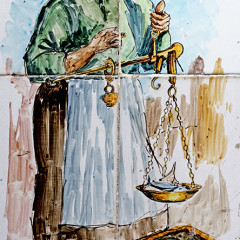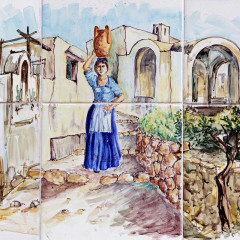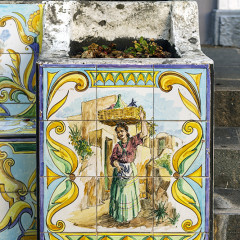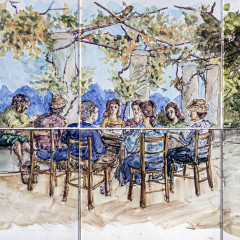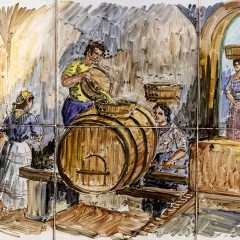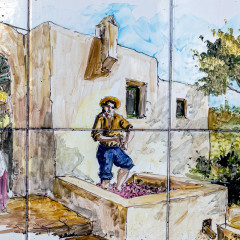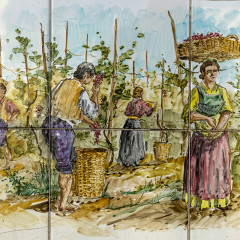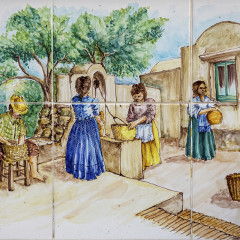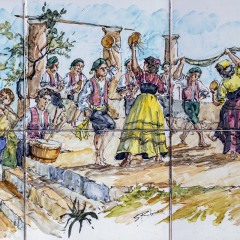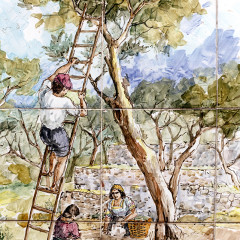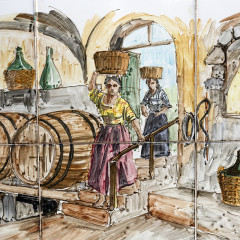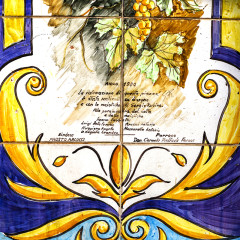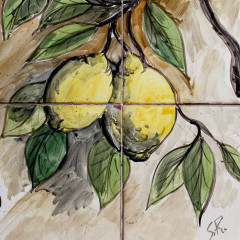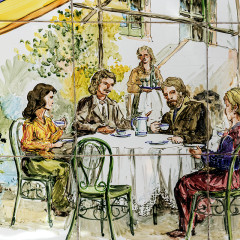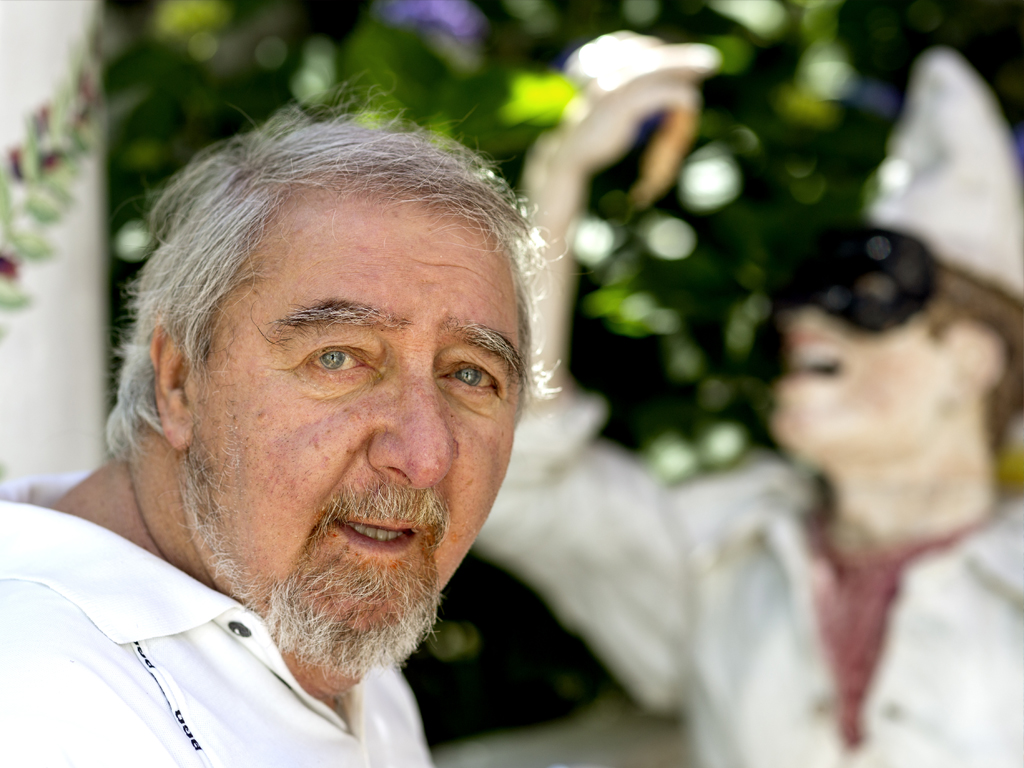
Panchine d’artista
Da quarant’anni incorniciano la piazza principale di Anacapri. Raccontano di antiche tradizioni e sono firmate da Sergio Rubino
di Riccardo Esposito | foto di Raffaele Lello Mastroianni
È estate, il sole splende ancora nel tardo pomeriggio. Passeggi per le strade di Anacapri, segui il viale principale e ti ritrovi di fronte alla chiesa di Santa Sofia con la sua facciata in stile barocco. Vuoi visitarla ma prima di entrare noti un particolare: la piazza è incorniciata da un’opera d’arte. Sono panchine ma non sembrano delle normali sedute.
Basta avvicinarsi per scoprire che c’è una storia raccontata sulla ceramica bianca. Sono scene di vita contadina. Si va dalla raccolta dell’uva ai banchetti, fino a una vera e propria festa con tarantella nel cortile di quello che dovrebbe essere un vecchio casolare.
Questa è Anacapri, un paese che non ha mai abbandonato definitivamente le sue tradizioni. E il tratto gentile che ha disegnato queste scene sulle panchine della piazza principale del paese sembra conoscere bene quest’anima rurale. La firma si trova in basso, come vuole la tradizione artistica, ed è quella di Sergio Rubino.
Da dove arriva l’idea di trasformare la piazza di Anacapri in un tuffo nel passato antico di questa terra? «L’idea è stata mia ma, immediatamente, è diventato un progetto corale che ha visto la partecipazione dell’intera comunità, fin dalla sua approvazione. L’incarico di rifare le panchine della piazza – racconta Sergio Rubino – l’ho ricevuto dal Comune di Anacapri. All’epoca il sindaco era Fausto Arcucci e c’era un problema da risolvere. Prima del mio intervento le panchine erano di mattoni in cotto e le persone si sporcavano facilmente dopo la pioggia».
Ed è così che da un bisogno pratico nasce l’incarico che ha permesso di inaugurare le nuove panchine esattamente quarant’anni fa, durante i festeggiamenti per Sant’Antonio. Ovvero il patrono di Anacapri. Non a caso il fil rouge con la storia e le tradizioni popolari è stato sempre voluto e amplificato dall’arte di Sergio Rubino.
«Sopra c’è la storia del paese, la sua origine contadina. Si può trovare la vendemmia, la raccolta delle olive e il contadino che cura le vigne. Le figure – sottolinea il maestro Rubino – erano comuni, tipiche del posto. C’è la donna che vende il pesce al mercato ma anche quella che porta il cesto in testa. Ho cercato di creare un legame sottile con l’anima del paese in modo che ognuno si possa riconoscere in questi personaggi storici».
In effetti è così, da anacaprese ho sempre sentito parlare delle donne del posto che non temevano il duro lavoro tra vigne e ulivi. E che, con il sole o la pioggia, partivano dai campi per raggiungere il mercato o la casa con i frutti della terra sistemati sul capo. Guardare queste ceramiche è come ascoltare i racconti di una nonna che custodisce con amore i suoi ricordi.
Poi, osservando bene quest’opera, ci si rende conto che i dettagli sono infiniti. Non a caso le energie investite nella realizzazione delle ceramiche sono state importanti ma il contributo esterno non è mancato. Sergio Rubino ricorda con entusiasmo queste fasi: «Il lavoro è stato chiuso nell’arco di un anno e ha visto la partecipazione di molti artigiani di qui».
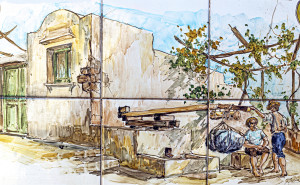 E c’è una testimonianza reale. Scendendo le scale verso piazza Boffe, con la chiesa sulla destra, si possono leggere i nomi delle persone che hanno partecipato alla messa in opera di questo monumento che diventa anche esempio di storytelling dal carattere mediterraneo.
E c’è una testimonianza reale. Scendendo le scale verso piazza Boffe, con la chiesa sulla destra, si possono leggere i nomi delle persone che hanno partecipato alla messa in opera di questo monumento che diventa anche esempio di storytelling dal carattere mediterraneo.
Sergio Rubino lo sottolinea con forza: vuole creare partecipazione. Le sue panchine formano la cornice di una piazza intesa come luogo di aggregazione della popolazione. In queste immagini tutti si rivedono e si riconoscono in una veste genuina.
«Con queste ceramiche ho cercato di far partecipare la gente, le ho inserite in un racconto a colori per creare una piazza di tutti e per tutti. Anacapresi ma non solo. In fondo, se ci si pensa bene, sono le persone che fanno la piazza e le panchine la incorniciano». La impreziosiscono, aggiungo io. La rendono unica. Anche perché il lavoro fatto sull’equilibrio delle forme e dei colori – non solo sulla scelta dei soggetti da riprodurre – è notevole anche all’occhio profano.
Sergio Rubino ricorda aspetti del suo lavoro che rispondono alle domande più tecniche. Ad esempio, come sono stati scelti i colori? «Non volevo appesantire la piazza più importante di Anacapri con tonalità estreme e invadenti. Quindi ho cotto a terzo fuoco, cioè un processo che serve per ottenere un risultato più resistente ma, al tempo stesso, meno chiassoso. Ho preferito colori modesti per non distogliere l’attenzione dalla chiesa e alleggerire la piazza».
Ed è proprio questo il risultato finale. Rubino ricorda anche l’emozione provata quando ha mostrato la prima panchina, ancora nel suo laboratorio storico in piazza Boffe. Qui Rubino, pittore, scultore e ceramista, affonda nei ricordi: «La panchina alla quale sono legato con più forza e affetto non si trova in piazza, ma lungo via Giuseppe Orlandi, poco distante da Santa Sofia. Quella è la prima panchina che ho terminato e quando il mio amico Leandro la vide nel laboratorio non riuscì a trattenere le lacrime. E rimase senza parole dall’emozione. Questo mi fece capire che la direzione era quella giusta».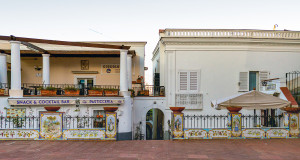
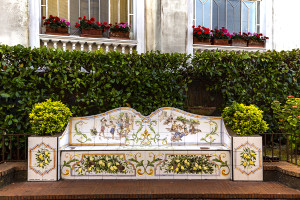
Se c’è una panchina preferita, molto probabilmente, esiste anche un disegno che ha un significato particolare per Sergio Rubino. Tra le varie rappresentazioni che raffigurano la vita anacaprese di un tempo ne possiamo citare una più importante o significativa? Rubino non ha dubbi: «Il ballo delle ragazze, la tarantella. È il disegno al quale sono più legato, ma è stato anche il passaggio più difficile da portare a termine». E osservando bene la sequenza riportata sulle panchine sembra proprio questa la scena conclusiva. Perché racchiude la fase finale, piacevole e gioiosa, di un’opera d’arte che racconta ciò che è stato. E che in fin dei conti è ancora oggi il vero cuore di Anacapri.
Un maestro ceramista
Sergio Rubino è un anacaprese doc. Nasce ad Anacapri nel 1948 e dopo gli studi artistici si dedica all’insegnamento come professore di educazione artistica. Apre un laboratorio 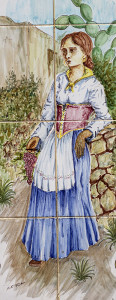 di ceramica e alimenta il suo stile, la sua idea di arte mediterranea rappresentata in forme differenti. Negli Stati Uniti d’America, negli anni Novanta, apre a Manhattan uno studio seguito poi dal Rubino’s Art Village sempre nello stato di New York. Quello delle panchine è solo uno dei progetti che il maestro porta a termine, tra le sue opere più importanti ricordiamo la decorazione con 200 mattonelle in ceramica del Sentiero dei Fortini di Anacapri e il restauro del Cristo ligneo del 1700 situato nella chiesa di Santa Sofia. | A master ceramics artist. Sergio Rubino is a true-born Anacapri native. He was born in Anacapri in 1948 and after studying art he became an art teacher. He opened a ceramics workshop and developed his own style, his idea of Mediterranean art represented in different forms. During the 1990s, he opened a studio in Manhattan in the USA, followed by Rubino’s Art Village, also in New York State. The benches are only one of many projects that he has completed: among his most important works are the 200 ceramic tiles that adorn the Sentiero dei Fortini (Trail of the Forts) in Anacapri and the restoration of the 18th century wooden crucifix in the church of Santa Sofia.
di ceramica e alimenta il suo stile, la sua idea di arte mediterranea rappresentata in forme differenti. Negli Stati Uniti d’America, negli anni Novanta, apre a Manhattan uno studio seguito poi dal Rubino’s Art Village sempre nello stato di New York. Quello delle panchine è solo uno dei progetti che il maestro porta a termine, tra le sue opere più importanti ricordiamo la decorazione con 200 mattonelle in ceramica del Sentiero dei Fortini di Anacapri e il restauro del Cristo ligneo del 1700 situato nella chiesa di Santa Sofia. | A master ceramics artist. Sergio Rubino is a true-born Anacapri native. He was born in Anacapri in 1948 and after studying art he became an art teacher. He opened a ceramics workshop and developed his own style, his idea of Mediterranean art represented in different forms. During the 1990s, he opened a studio in Manhattan in the USA, followed by Rubino’s Art Village, also in New York State. The benches are only one of many projects that he has completed: among his most important works are the 200 ceramic tiles that adorn the Sentiero dei Fortini (Trail of the Forts) in Anacapri and the restoration of the 18th century wooden crucifix in the church of Santa Sofia.
Artistic benches
They have framed the main piazza in Anacapri for the past forty years. Designed by Sergio Rubino, they tell us about ancient traditions
by Riccardo Esposito | photos by Raffaele Lello Mastroianni
It’s summer, and the sun is still shining in the late afternoon. Walking around the streets of Anacapri, you stroll along the main avenue and find yourself in front of the Baroque facade of the church of Santa Sofia. You want to visit it, but before entering the church you notice something unusual: the piazza is framed by works of art. They’re benches, but nothing like the usual kind of seating.
If you go closer, you’ll discover that a story is told on the white ceramic. The benches show scenes of country life, from harvesting the grapes to feasting, and a genuine festival with a tarantella in the yard of what seems to be an old rustic cottage.
This is Anacapri, a town that has never completely abandoned its traditions. And the fine brush that painted these scenes on the benches in the main town piazza seems to know this rural spirit very well. The signature at the bottom, in keeping with artistic tradition, is that of Sergio Rubino.
Where did the idea to transform the piazza in Anacapri into a trip back into the past of this place originate? “It was my idea, but the project immediately became a team effort that the whole community took part in, right from the day it was approved,” explains Sergio Rubino. “The Anacapri town council assigned me the job of re-doing the benches in the piazza. At that time, the mayor was Fausto Arcucci and there was a problem to solve. Before this project, the benches were made of terracotta bricks and people sitting on them would often get dirty after it had rained.”
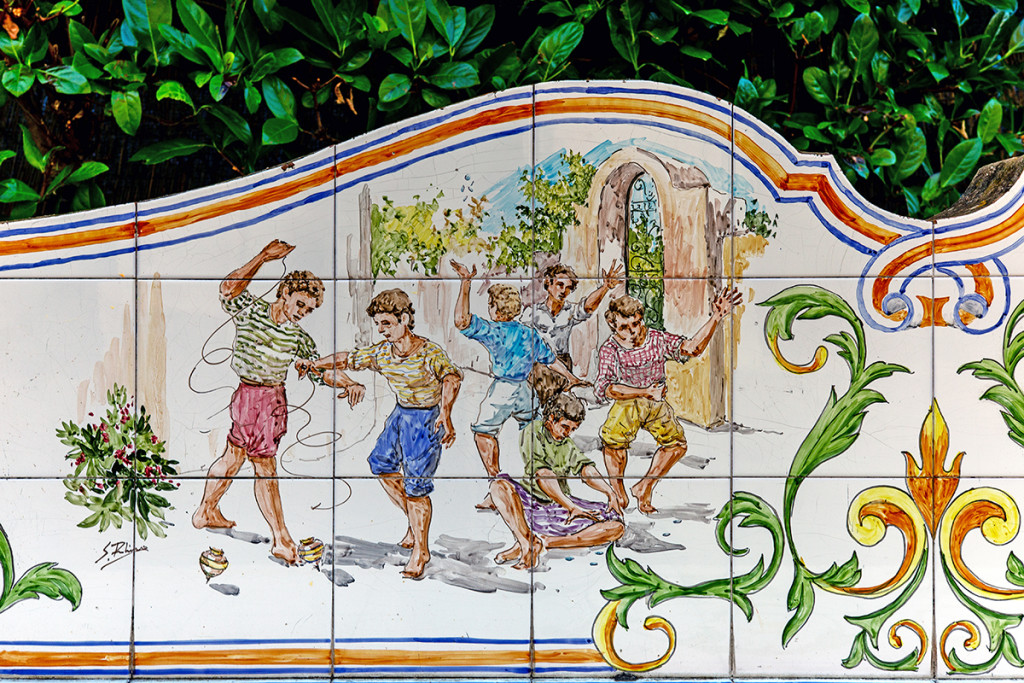 So a practical necessity gave rise to the job that led to the inauguration of the new benches exactly forty years ago, during the festivities for the feast of Sant’Antonio, the patron saint of Anacapri. It is no coincidence that this motif linking them with history and popular tradition is something that Sergio Rubino has always sought and developed in his art.
So a practical necessity gave rise to the job that led to the inauguration of the new benches exactly forty years ago, during the festivities for the feast of Sant’Antonio, the patron saint of Anacapri. It is no coincidence that this motif linking them with history and popular tradition is something that Sergio Rubino has always sought and developed in his art.
The benches show the history of the town, and its peasant-farming origins. You can find the grape harvest, the olive harvest and the peasant farmer tending to the vines. These were common figures, typical of the area,” Rubino points out. “There’s the woman selling fish in the market and the woman carrying a basket on her head. I tried to create a subtle link with the spirit of the town so that everyone could see themselves in these historic characters.”
And that is what he did: as a native Anacaprese I’ve always heard people talk about the Anacapri women who laboured in the vineyards and olive groves. In sunshine or in rain, they would leave the fields to go to market or go home carrying the fruits of the earth on their heads. Looking at these ceramic benches is like listening to the stories of a grandmother who has lovingly preserved her memories.
And if you look at the benches carefully, you realize that there’s an infinite amount of detail. Huge energy was certainly invested in creating this ceramic work, but an important contribution came from other sources, too. Sergio Rubino remembers the phases enthusiastically: “The work was completed in the space of a year, and a lot of craftsmen from the area also participated.”
And there is concrete evidence of this. As you go down the steps to Piazza Boffe, with the church on the right, you can read the names of the people who took part in creating this monument, which has become an example of storytelling Mediterranean-style.
Sergio Rubino emphasizes this forcefully: he wants to create participation. His benches form the frame for a piazza that is seen as a place where the townspeople can gather. Everyone can see themselves in these images and can recognize a genuine portrayal of themselves.
“With these ceramic works, I’ve tried to get people to participate; I’ve included them in a story in full colour, to create a piazza of everyone and for everyone. Anacapri inhabitants, and others too. After all, when you think about it, it’s the people who make the piazza and the benches frame it.” And make it beautiful, I add. They make it unique. Partly also because this work of art, created from a harmony of shapes and colours – not just the choice of subject matter – is impressive even to the uninitiated eye.
Sergio Rubino remembers aspects of his work that respond to the most technical questions. For example, how did he choose the colours? “I didn’t want to make this piazza, the most important one in Anacapri, look heavy by using extreme, intrusive colours. So I used third-firing on the ceramic glaze, a process which helps to produce a result that is more durable but also less gaudy. I preferred modest colours so as not to detract attention from the church, and in order to lighten the piazza.”
And this is indeed the result he achieved. Rubino also remembers the excitement he felt when he displayed the first bench, still in his old workshop in Piazza Boffe. Here Rubino, a painter, sculptor and ceramics artist, delves into his memories: “The bench I’m most attached to and feel most fondness for isn’t in the piazza, but is in Via Giuseppe Orlandi, not far from Santa Sofia. It’s the first bench I finished and when my friend Leandro saw it in my workshop he couldn’t hold back his tears. He was speechless from emotion. That made me realise I was on the right track.”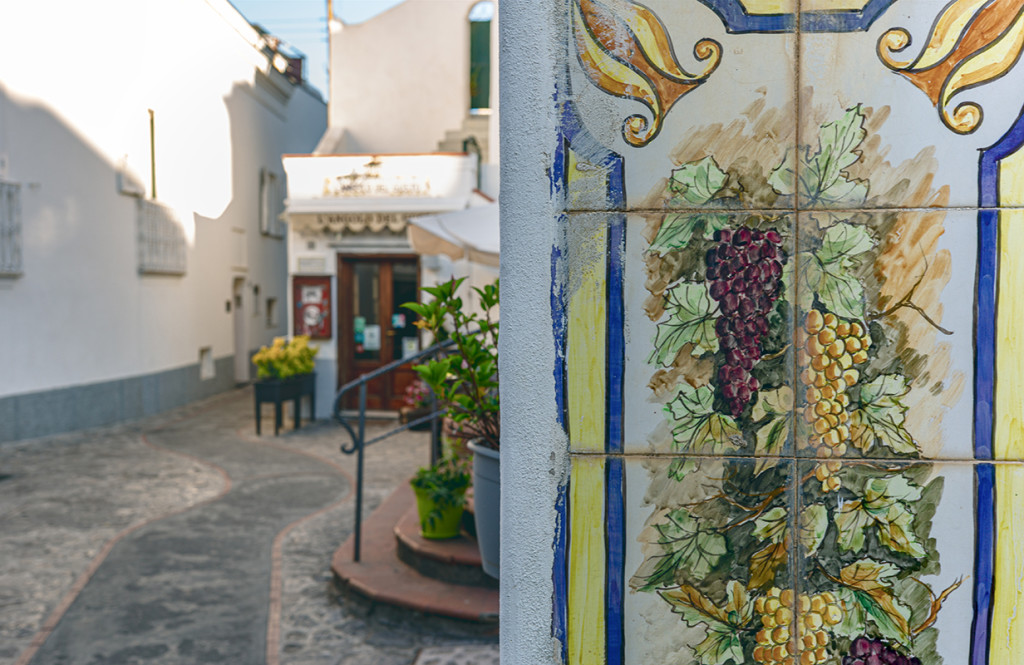
If there is a favourite bench, there is probably also a picture that has particular significance for Sergio Rubino. Among the various representations that depict the Anacapri life of the past, is there one that is more important or significant for him? Rubino doesn’t hesitate: “The girls dancing the tarantella. That’s the picture I’m most attached to, but it was also the most difficult to complete.” And looking at the sequence of pictures shown on the benches, that seems to be the conclusive scene. Because it contains the final happy and joyful phase of a work of art that tells the story of what once was. And that, in the end, is still today the true heart of Anacapri.






